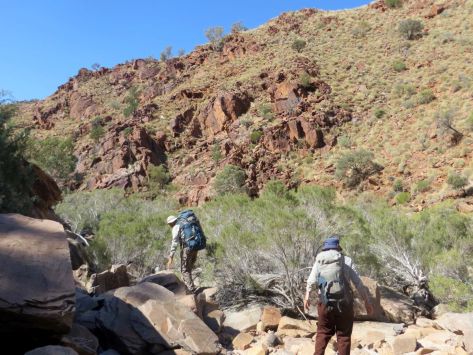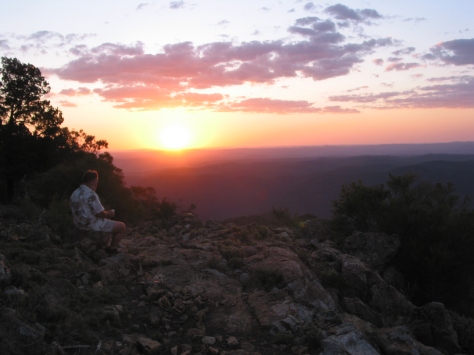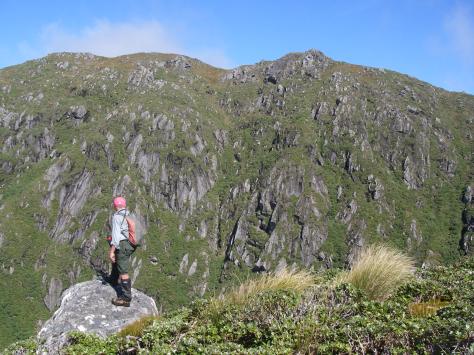Over six decades of bushwalking I have ranged across most of Australia’s varied landscapes on multiday hikes with my family and bushwalking friends. These hikes have taken me to locations as diverse as the alpine landscapes of Tasmania, Kosciuszko, Namadgi, The Bogong High Plains; coastal walks at Wilson’s Prom, Tasman Peninsula, Freycinet Peninsula, bay of Fires and The Great Ocean Road; the massive sand landscapes of Fraser Island, Cooloola, Moreton Island, Stradbroke Island and The Cape to Cape in WA; the arid interior of Central Australia, Western Australia, SW Queensland and the Flinders Ranges; the tropical savannahs of Kakadu and Nitmuluk; Queensland’s Central Highlands Sandstone Belt and White Mountains; the dense rainforests of Lamington, the Conondales and Hinchinbrook Island; and the granite landscapes of the New England Tableland.

A Word about Snakebite Treatment
There is plenty of information about snakes and treatment of snakebite. The Queensland Health website is a good starting point. Also a brochure published by the ACT Government “Living with snakes” is an excellent reference point. The general points for bushwalkers are:
- Treat all snakes encountered with caution. Never ever try to pick one up. Allow them to get out of your way. Be alert at all times in the bush especially in the morning when snakes are likely to be sunning themselves. Cover up with gaiters and/or long trousers. Avoid long grass wherever possible.
- All bushwalkers in Australia should know their pressure immobilisation techniques: Apply a broad pressure bandage over the bite site as soon as possible. Crepe bandages are ideal, but any flexible material may be used in an emergency. Clothing, towels etc can be torn into strips. Panty hose has been successfully used. I carry a 10cm x 3.5 m Setopress high compression bandage in a separate pouch where I can access it easily. Apply over the bite and work your way up the limb with even pressure. Don’t wash off the venom and don’t apply a touriquet or any chemicals. The patient should lie down and keep still as venom is distributed through the lymphatic system which is activated by movement. Reassure your patient. Contact emergency services via mobile/sat phone or set off PLB. Mark the location of the bite on the bandage for future reference by medical staff. Immobilise the limb with a splint and bind one leg to the other if bite is on leg. Monitor patient.
A Cautionary Tail.
This is not meant to be a rollicking tale of Man vs Wild. On summer trips in Australia I have always kept a lookout for snakes sunning themselves on the tracks especially when walking alone.
On a seemingly benign outing to the Bunya Mountains in South East Queensland with some natural history friends we checked out a bird’s nest close to Paradise Car Park. When the others drifted back to their cars to drive to the Westcott picnic area I decided to walk the three kilometres along the track, which is quite scenic. It sidles along the western cliff line, tracking in and out of patches of rainforest and open eucalypt forest.
I was armed with a camera but had left my day pack with water bottle, food, first aid kit, mobile phone, tick freezer, gaiters etc back in the ute. Although I had walked this track numerous times before, I ignored the niggling thought that I really should walk back the 200 metres and collect my pack as I would be out walking by myself on a section of the track which I knew was “snaky”.
After about a kilometre the benched track leaves the rainforest and contours along a cliff line in open Eucalypt forest. Of course, sprawled across the track enjoying a patch of sunlight was a goodly sized and sleek Pseudonaja textilis, known to you and I as an Eastern Brown snake. Larger than I seen seen for a long time. Venomous, aggressive and dangerous. Capable of inflicting a fatal bite…if my memory served me correctly.

On returning home I looked up snake bite statistics:
-
Brown snakes are responsible for about 60% of bites in Australia. Brown snakes are territorial, aggressive and dangerously venomous.
-
Of the 50 deaths ( approx) from snake bite in Australia since 1980, 32 were from brown snakes.
-
In the 24 hours when I was writing this, the Queensland Ambulance Service responded to eight snake bite incidents.
-
Over the 2015-2016 summer the QAS responded to an average of two call-outs per day for snake bite.
My Reptiles of Brisbane booklet published by the Queensland Museum has this to say about Eastern Brown snakes:
Dangerously venomous; responsible for many human deaths. Primarily active by day… This species is responsible for most significant snakebites in Queensland. It will avoid humans… but if cornered or molested, it responds aggressively, raising the front of its body off the ground in a characteristic ‘S’ shape.
What to do? Well, not much really. What I immediately thought was that I really shouldn’t be walking here without at least a first aid kit with compression bandages.
As for our ectothermic friend, he was pretty immobile from yesterday’s cold southerly change: wind, showers and mist. So he was in no mood to shift and I wasn’t about to scrabble through snake-infested grass tussocks and rocks to get around him. Certainly I wasn’t about to grab it by the tail or the scruff of the neck as a walking friend from my youth would have done…unhesitatingly. My friend was a amateur herpetologist. Unsurprisingly he came to an untimely death, aged 39. But not from the attentions of a snake. He died in a collision between two F/A18 Hornets over the Northern Territory.
I exhausted my anti-snake repertoire of stamping, making heaps of noise, rolling small rocks near it. The usual things that have served me well in the past. Unfortunately my interventions made my new best friend more energized, alert and aggro, rearing up into its threat pose and making lunges in my direction. I edged back.
I pondered my predicament. My newly acquired best friend, the Eastern Brown, settled back for another wary snooze. I thought seriously about backtracking to Paradise carpark but that was pretty wussy. In the end I gently bowled a fist-sized basalt cobble along the track and pinged our friend midships. Another round of impressive rearing and lunging and finally a 180° turn and it disappeared up the track wall. Downhill would have been nice.
But I scuttled past keeping a wary eye on the length of glossy tail that my friend left dangling and twitching strategically over the rock face. Just to remind me of who was boss of this territory.
Insignificant as all this will seem to experienced walkers, at the time I had been slack enough to leave my walking kit back in the ute even though I had spotted snakes on this track before. To rub salt into the wounds, when we arrived home two new-fangled Setopress high compression bandages had been left on my front verandah by a kind bushwalking friend.
Recent Journals:















